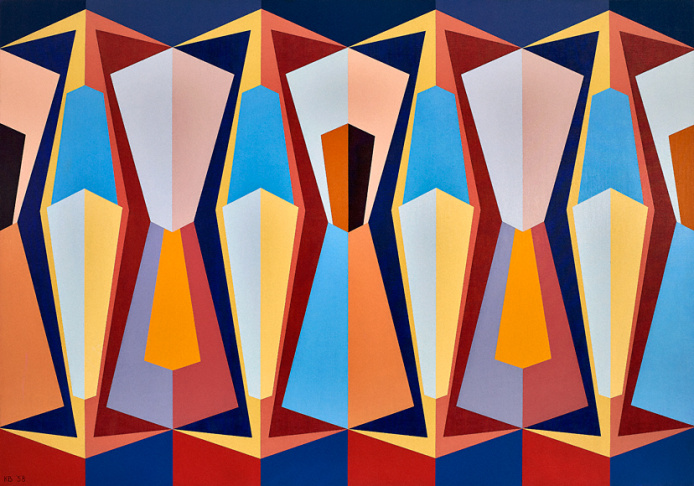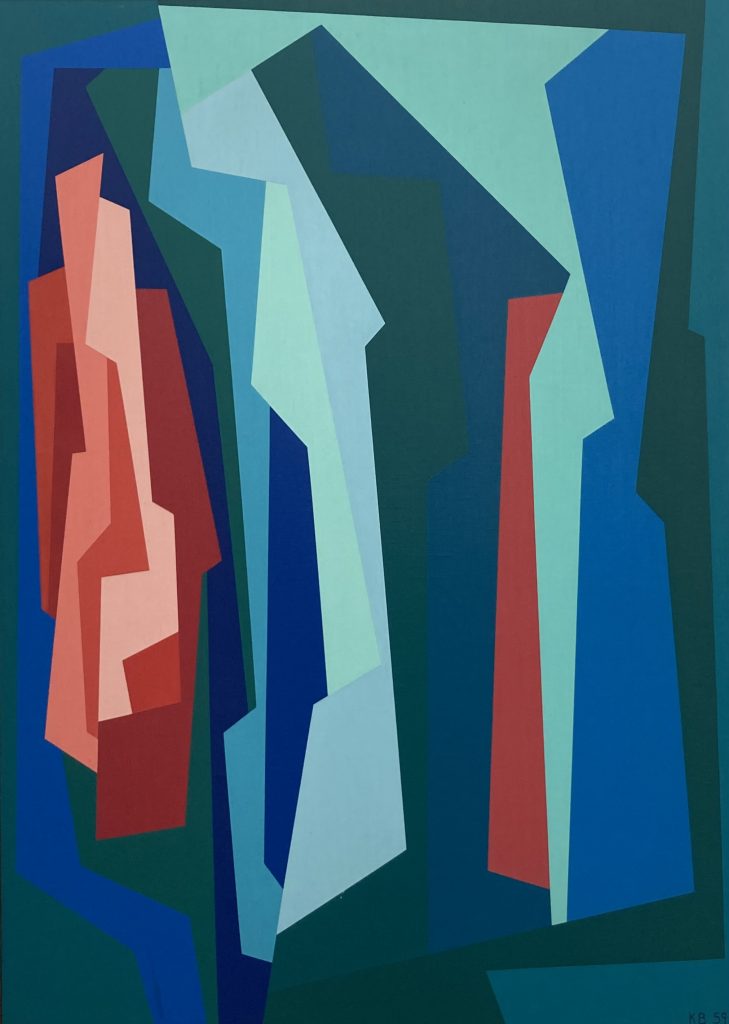Ex-voto: The Mexican Art of Gratitude
When tragedy or misfortune happens, some people turn to a greater power. The possibility of divine intervention gives them hope. Usually, these...
Jimena Escoto 16 January 2023
25 September 2023 min Read
Could a painting style capture the aesthetic of an entire era? Could it give form to the bouncy, cool optimism of post-bebop jazz music? Karl Benjamin’s Hard-edge paintings do just that.
Hard-edge painting combines the precise composition of geometric abstraction with fields of clean-edged bold color. Hard-edge painting became synonymous with the emotionless, deliberately impersonal, yet optimistic spirit of the mid-20th-century aesthetic. Associated with the New York School and color field painting, the style recalls the geometric abstraction paintings of Wassily Kandinsky, Josef Albers, and Piet Mondrian. Karl Stanley Benjamin (1925- 2012) was an American painter and ardecharnt practitioner of the art form mentioned, who also led the Hard-edge painting movement as one of the celebrated Los Angeles-based Abstract Classicists.
Before his painting career, Benjamin served in the U.S. Navy during World War II. When leaving military service, Benjamin obtained teaching credentials and was hired, in part, to teach art classes once a week at a local public school. During his tenure, he encouraged his students to think about color schemes and how to fill the paper with colors, which Benjamin deemed profoundly crucial to his artistic development. Concurrently, Benjamin began exploring the galleries in Los Angeles and Pasadena, California, and studying the New York School.

Karl Benjamin, Stage II, 1958, private collection. KPCC archive.
Benjamin’s first major solo show was held in 1954 at the Pasadena Art Museum, now the Norton Simon Museum of Art. His paintings probed into color relationships with tightly balanced compositions, even though he had no formal background in color theory. Benjamin’s painting career blossomed among the vibrant mid-twentieth-century art, design, and architecture in the greater Los Angeles area. His works epitomized the cool, crisp characteristics of those mid-century scenes. The 1956 Art in Architecture at Barnsdall Art Park in Los Angeles, California, was Benjamin’s next significant contribution to Hard-edge painting. While it was considered a keynote early mid-century art exhibition and, for that reason, garnered him critical acclaim, Benjamin remembered it as “a good excuse for making abstract paintings.“1
Then, in 1959, Karl Benjamin, Lorser Feitelson, Frederick Hammersley, and John McLaughlin were exhibited in Four Abstract Classicists at the San Francisco Museum of Modern Art. The international exhibition secured Benjamin’s recognition as an abstract painter. Using oil and a pallet, in Benjamin’s Hard-edge paintings, color and shape are inseparable entities.
The exhibition was renamed West Coast Hard-edge when it traveled to the Institute of Contemporary Arts in London and Queen’s University in Belfast, Northern Ireland. In the exhibition catalog, curator Jules Langsner, whom Benjamin credited with coining “Hard-edge painting,” wrote that Hard-edge compositions are “finite, flat, rimmed, by a hard, clean edge. These forms are not intended to evoke in the spectator any recollections of specific shapes he may have encountered in some other connection. They are autonomous shapes, sufficient unto themselves as shapes.”2 These qualities can be seen in Red, Pink with Blue-Green (1959), where Benjamin used repeating, asymmetrical forms and colors to create balance, harmony, and dynamism.

Karl Benjamin, Red Pink with Blue-Green, 1959, Benton Museum of Art Pomona College, Claremont, CA, USA.
Afterward, Benjamin completed his MA in 1960 at Claremont Graduate School, now Claremont Graduate University. However, Benjamin admitted he found Claremont’s art scene too conservative, stating: “At that time… when you were out here [in Claremont], you either painted like the Millard Sheets crowd…or if you were an abstract painter, you had to be in the New York School with brushy stuff. If you didn’t fit in those categories, a Sheets type realist or the other kind, there was no word for it.”3
In 1962, the Whitney Museum of American Art displayed Benjamin’s art in Geometric Abstraction in America. The New York Museum of Modern Art followed with an exhibition called The Responsive Eye three years later. Benjamin’s paintings, No. 3, 1970, and No. 15, 1971, demonstrated how Hard-edge painting could manipulate geometric forms to embody preciseness. In 1979, Benjamin joined the faculty at Pomona College as a professor and artist-in-residence. He proceeded to win the National Endowment for the Arts grants in 1983 and 1989, which led to Pomona College appointing Benjamin as Loren Babcock Miller Professor of Fine Arts at Pomona College in 1991.
I know I wore out Miles Davis records…when I got out of the Navy, when I got back from overseas, I was stationed in New York. The war had just ended, and we were a flight crew, so we had nothing to do… three nights out of four, I was at 52nd Street, which was the place then: Dizzy Gillespie, Coleman Hawkins… Billie Holiday, I’ll never forget that year. I really loved that stuff, which was cool.
Benjamin, Karl, Interviewee., Perchuk, Andrew, Interviewer., Learner, Tom, Interviewer., Rani. Singh, Catherine. Taft, Peter Kirby, and Getty Research Institute. Karl Benjamin Oral History Interview (2009)
Benjamin’s work was later featured in Birth of the Cool: California Art, Design, and Culture at Mid-Century at the Orange County Museum of Art. The exhibition ran from 2007 to 2009, highlighting the connection between architects, designers, musicians, avant-garde moviemakers, and painters of mid-century California. The role of music in Benjamin’s painting process, particularly that of classical music and jazz, was further showcased and elucidated.
I can think of no other artist whose paintings exude the joy and pleasure of being an artist with more intensity than Karl Benjamin’s nor any other artist whose long teaching career has left no blemish of cynicism on his practice.
quoted in Muchnic and Times
Benjamin’s early Hard-edge paintings feature prominently in “Tracing the Edge” at the Benton Museum of Art in Claremont, California (August 23, 2023 – January 7, 2024).
Karl Benjamin. Interview with Karl Benjamin, 2009.
Los Angeles County Museum of Art., Four Abstract Classicists, 1959.
Karl Benjamin. Interview with Karl Benjamin, 2009.
“Hello, Cool World: Painter, Karl Benjamin”
Karl Benjamin. Interview with Karl Benjamin, 2009.
Karl Benjamin (interviewee), Andrew Perchuk Andrew, (interviewer), Tom Learner (interviewer), Rani Singh, Catherine Taft, Peter Kirby, and Getty Research Institute. Karl Benjamin Oral History Interview (2009).
Los Angeles County Museum of Art. Four Abstract Classicists: Karl Benjamin, Lorser Feitelson, Frederick Hammersley, and John McLaughlin. 1959.
“Hello, Cool World: Painter, Karl Benjamin.” EichlerNetwork. Accessed September 11, 2023.
Suzanne Muchnic and Special to the Los Angeles Times. “Karl Benjamin Dies at 86; Painter Created Colorful Geometric Works.” Los Angeles Times, July 26, 2012. Accessed September 11, 2023.
DailyArt Magazine needs your support. Every contribution, however big or small, is very valuable for our future. Thanks to it, we will be able to sustain and grow the Magazine. Thank you for your help!